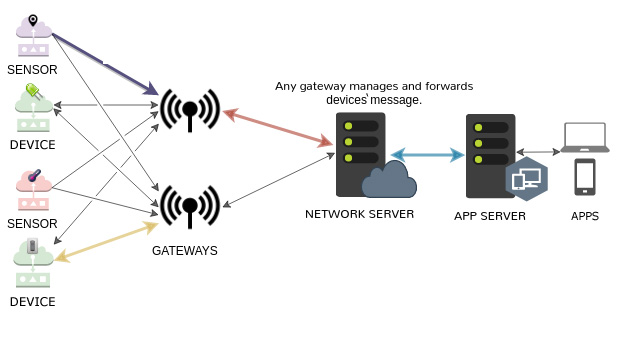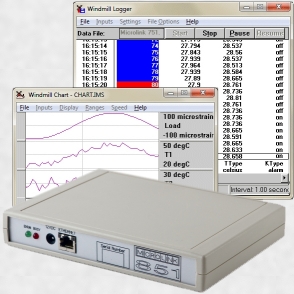Monitor - ISSN 1472-0221
The Newsletter for Data Acquisition and Control
Issue 269 April 2021
Continuing our Internet-of-Things and smart cities series - connecting remote instruments over several kilometres.
You can download a pdf copy of this newsletter here.
Contents
* Using LoRaWAN for Remote Monitoring
* Your DAQ Questions Answered
* Data Acquisition News Round-Up
Using LoRaWAN for Remote Monitoring
Web link: https://www.windmill.co.uk/LoRaWAN-remote-monitoring.html
LoRaWAN connects sensors and devices to the Internet-of-Things, often over long distances.
Long Range - 5 to 832 km
LoRaWAN stands for Long Range Wide Area Network. It wirelessly connects battery operated "things" to the internet, using radio frequency bands. For example, in Europe it uses the 863 to 870 MHz band. The stated range is 16 km in a clear line of sight and 5 km in built-up environments. The world distance record, though, is 832 km. This was made with a LoRaWAN sensor attached to a high altitude helium balloon.
Penetrates Barriers
At shorter distances Lorawan can be used underground and will penetrate concrete.
Long Battery Life
The system uses very little energy when communicating with sensors. Batteries can last for 10 to 15 years.
Bi-Directional
In default mode (class A), communication is initiated by the end device (such as a sensor). The device can send data at any time. It then leaves a window to receive instructions. This is the lowest power consumption mode. In other modes the network server can also initiate communications. Modes can be switched to save power.
Many Devices from a Single Gateway
It is easy to scale and expand networks. LoRaWAN devices broadcast their messages to a gateway. An 8-channel gateway can handle a few hundred thousand messages a day. So if each device sends a message every 5 minutes, one gateway would support around 350 devices. If each device sent just ten messages a day, their number would go up to around 10 000 devices per gateway. With more gateways, more sensors and devices can be connected. The gateways will accept messages from all sensors within reach.
The gateways forward data to the LoRaWAN network server. These connections can be by Wi-Fi, Ethernet or cellular. In Issue 267 we discussed MQTT. This communication protocol can be used between the gateway and the network server (broker).
The network server or broker makes data available to the user applications, such as pollution monitoring or car counting apps.

LoRaWAN architecture, modified from original image by Brivadeneira, CC by 4.0.
Security
Systems are deployed on public or private networks. LoRaWAN uses Advanced Encryption Standard (AES) and 128-bit cryptographic keys and algorithms.
Applications
LoRaWAN is ideal for remote counting due to its low power consumption and long distance communication. For example, Retail Sensing are using it to count illegally parked cars in national parks, providing park authorities with information about numbers of cars every few minutes. It is also a commonly used communication method in smart cities.
Other uses include building automation, health monitoring, farming, pollution monitoring and other data acquisition and control applications.
Your Data Acquisition Questions Answered:
Question
We are a small research group and as a part of our project we need to monitor 6 strain gauges at the same time. Kindly, if you could recommend one of your cost effective data acquisition system for this purpose.
Answer
If you are monitoring static strain where the values are not changing over times less than 1 second, then either:
Microlink 751 + ML594 (USB connection to PC)
Or
Microlink 851 + ML594 (Ethernet/internet connection to PC)

The Microlink 851
For dynamic strain, for example for for impact measurements then choose the Microlink 770 + ML594
The ML594 is a strain guauge connection box for up to 16 guauges. The gauges can be connected in full, half or quarter bridge circuits.DAQ News Round-up
Welcome to our round-up of the data acquisition and control news. If you would like to receive more timely DAQ news updates then follow us on Twitter - @DataAcquisition - or grab our rss feed.
Real-time insights into the inner life of plants with new biosensor
The hormone auxin is of central importance for the development of plants. Scientists have developed a novel sensor that makes the spatial distribution of auxin in the cells of living plants visible in real time.
Source: University of Bayreuth
https://www.uni-bayreuth.de/
'Agricomb' Measures Multiple Gas Emissions From Cows
Optical frequency comb measures emissions of methane, ammonia, carbon dioxide and water vapor from the atmosphere around cattle. It could help optimise agricultural processes to reduce production of heat-trapping greenhouse gases.
Source: NIST
https://www.nist.gov/
Vibrations from a smartphone can help spot unsafe drinking water
The vibrations from an iPhone's ringtone can be used to measure the viscosity of a liquid, which could allow it to detect whether water is polluted or to test for pregnancy by measuring the levels of hormones in urine.
Source: New Scientist
https://www.newscientist.com/
Smart sensors to provide real time data for optimized operation of district heating grid
Intelligent sensor system will precisely monitor the Denmark heating grid and help heating plants save enormous sums on monitoring, maintenance and heat loss.
Source: EurekaAlert
https://www.eurekalert.org/
Mussel sensors pave the way for new environmental monitoring tools
Using magnetometers and accelerometers, researchers have created a "Fitbit" for mussels which, when a bed of mussels simultaneously close their shells, alerts to the presence of toxins in the water .
Source: SCUBA News
https://news.scubatravel.co.uk/

* Copyright Windmill Software Ltd
* Reprinting permitted with this notice included
* For more articles see https://www.windmill.co.uk/
We are happy for you to copy and distribute this
newsletter, and use extracts from it on your own web
site or other publication, providing the above notice
is included and a link back to our website is in place.
For previous issues by subject see https://www.windmill.co.uk/monitorindex.html
SUBSCRIBING OR CANCELLING SUBSCRIPTION Visit https://www.windmill.co.uk/newsletter.html and add or remove your e-mail address.
Windmill Software Ltd, PO Box 58, North District Office,
Manchester, M8 8QR, UK
Telephone: +44 (0)161 834 6688
Facsimile: +44 (0)161 833 2190
E-mail: monitor@windmillsoft.com
https://www.windmill.co.uk/
https://www.windmillsoft.com/
